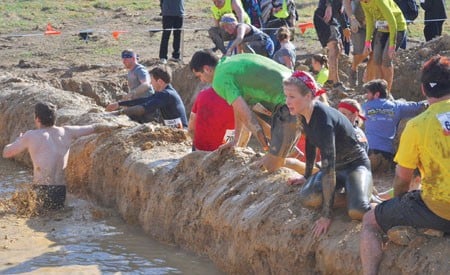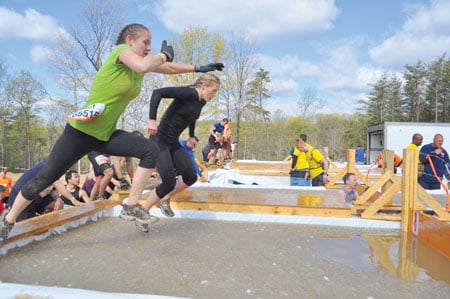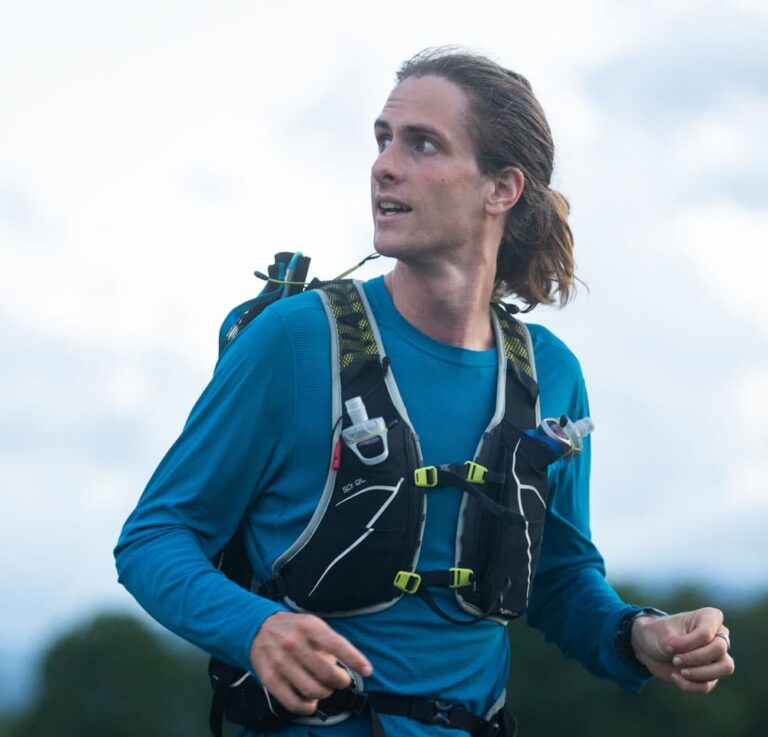At some point during the half-mile, slightly uphill trek toward transportation — complicated by seized-up hip flexors and frozen fingers that couldn’t get the Clif Bars into my mouth quickly enough — I started thinking about what would come after the Tough Mudder we’d just completed.
Sure, there would be Chik-Fil-A and hot showers en masse. But, after that, I’d have to write about it. And that meant I’d probably have to break one of the Tough Mudder rules: No whining.
The emcee had listed off this rule when he rallied the troops before the start of the mud race that bills itself as “probably the toughest event on the planet.”
I resisted the urge to whine for most of the race. But between the mid-40s weather at our 8:30 a.m. start and the onslaught of water obstacles (one, a dumpster filled with ice), the next five hours were the coldest of my life.
The Tough Mudder — when taken at its nearly 12-mile, 22-obstacle whole — was quite tough. No one event was impossible, though some were more taxing than others (did I mention the Arctic Enema?). But add in nonstop shivers (yes, a symptom of hypothermia) and a little electric shock therapy, and it’s no wonder several teams spent half their time working out cramps on the sidelines.
But all these details — and especially my whining — seemed trite in light of what I learned a few days after our race.
We hadn’t yet jumped into water, per se, but were certainly soggy by the time we arrived at our fourth obstacle.
“Walk the Plank,” the sign said. Great. This was the obstacle that really tapped into my fears, jumping almost 15 feet into a deep pool of muddy water. It didn’t help that a logjam of people waiting to take the leap gave me even more time to think about it. “Just climb up the wall, don’t look, and jump,” I told myself.
I was repeating these mental motions when a military-uniformed volunteer interrupted.
He was directing traffic toward the obstacle and talking to people as they passed. I thought his words would be motivating, maybe another of those “Oo-rahs!” that the Tough Mudder used as its battle cry.
But they were words of caution: Keep moving when you get in the water, he told us. Someone before us hadn’t come up right away and they think people may have jumped on top of him.
Great. My turn. I crept toward the plank slowly, not wanting time to contemplate this new information. My husband had just taken the leap, so I waited at the top to see his head pop up.
I was staring at the spot where he’d entered the water, expecting him to come up for a breath. Five seconds felt like a full minute before I spotted him — already at the other end, climbing out of the muddy pool.
“Did you really have to swim underwater?” I thought to myself. I sighed, relieved, and then stepped off the platform (with a more girlish yelp than I’d like to admit).
This particular obstacle hadn’t been the focal point of my race—until I heard the news.
Someone died from it.
Later that afternoon, Avishek Sengupta, a 28-year-old from Ellicott City, Md., had to be pulled from the muddy water after he had been submerged for several minutes, according to initial reports.
Emergency officials — Tough Mudder posts some 75 of them around the course — were able to resuscitate him, but Sengupta died at the hospital from brain injuries the next day, news reports said.
The Virginia medical examiner’s office ruled the death an accident. Tough Mudder officials said they could not provide additional details due to an ongoing investigation.
Sengupta’s was the first death resulting from a Tough Mudder event. In the company’s three-year history, 750,000 people have participated in more than 50 Tough Mudders across the world. Our mid-April race, along with another on Sunday, drew 14,000 people to a military training center in West Virginia’s panhandle.
Spokeswoman Ashley Pinakiewicz said the company’s East Coast events have been some of its biggest. Considering the high number of participants and the thorough nature of the waivers we signed — “this agreement applies to personal injury (including death)” — I was honestly surprised that this death was the event’s first.
City Hospital in Martinsburg, W. Va., treated 20 patients with injuries from the Tough Mudder races the weekend we participated, according to a statement issued by the hospital. They treated participants for heart attacks and two, including Sengupta, for near-drowning injuries. More than a dozen others suffered from orthopedic, head and hypothermia injuries, the hospital said.
Our team of five signed up for the Tough Mudder to “bond.” We’re headed on an overseas mission trip this summer and thought the semi-torturous event would, if nothing else, teach us to rely on each other.
It did. For all the hype and hollerin’ at the start of the Tough Mudder, I found they weren’t exaggerating about its brotherly nature.
I was impressed when, at the first obstacle, I watched a paraplegic man leave his hand-cycle wheelchair, intended for off-road uses, to Army crawl under barbed wire, not seeming to notice the scrape it left on his Mohawk-ed skull. But I was even more impressed when I saw his teammates flank the chair to push him up the steep hills.
But he wasn’t the only one who had help.
I bonded not only with my group, but also with perfect strangers (especially the one who reached up and shoved my butt over a mound of mud with no footholds — thanks).
In fact, perhaps the hardest part of doing this race as a girl is that most of the guys barely let you. My own husband was an offender in this category, wrapping his arms around me like a cocoon at the top of the half-pipe obstacle called Everest. Granted, by this 20th obstacle, all my I-teach-fitness-classes pride had faded and I probably would have let any one of the chivalry-high men carry me on his back to the finish line.
But I didn’t. I finished. I wrapped my frozen fingers around my hard-earned beer, wishing it were warm.
We drove home, posted pictures on Facebook and analyzed the appearance of new bruises for days. One teammate had already suggested signing up for another.
But when we found out that someone didn’t finish — that someone didn’t survive — it all felt trivial.
Was it worth the risk? Will another 14,000 people sign up to do the same event at the same place in October?
In many ways, the Tough Mudder events are about competing on behalf of those who can’t. Participants have raised more than $5 million for the Wounded Warrior Program, a nonprofit benefitting injured service members. The Boston Marathon bombings just days before our Tough Mudder event seemed only to galvanize the teams, who donned shirts in remembrance of those who lost limbs and lives. They chanted their “Oo-rahs!” loudly, exercising their right to race, their right to risk.
One week after Sengupta’s death, participants at an event in Ohio donned black armbands and headbands in Sengupta’s memory. They said on Facebook pages that they were running for him.
While Sengupta’s death may become for some a reason not to sign up, it would quickly become, for others, a cause worth running for. •









